Learning and Development: Definition, Jobs, L&D Strategy and Best Practices

Learning and development is one of the core HR responsibilities and significantly affects business success. Without it, employees don’t grow, and companies face many issues in their workflow that they are unable to fix. With L&D, your team is constantly upskilling and reskilling, ready to overcome multiple challenges and reach new heights.
In this article, you’ll find out what learning and development is, the jobs it involves, the objectives it sets, how to create an L&D program, and how to formulate a winning L&D strategy for your company. Let’s get started!
What Is Learning and Development?
Learning and development (L&D), or training and development, is a systematic process of enhancing employees’ professional skills and knowledge. The primary goal is to drive business success by increasing employee productivity and effectiveness.
L&D can be realized in different ways, depending on the organization’s size and how much resource it can invest. Let’s see what learning and development looks like in large and small companies.
Learning and development in large companies
Big companies have a lot of resources and a significant number of employees who need to be trained. Such organizations usually have highly structured corporate training, with an L&D team in charge of it.
Their task is to identify training needs, develop (or provide access to) relevant training modules and programs, monitor progress, and fix issues as needed. Depending on their strategy, an L&D team can develop online courses, organize training sessions with coaches, find specialized training platforms with ready-made training materials, and more.
Learning and development in small companies
In small companies, learning and development looks different and is dependent especially on the training budget the organization can afford. There are no L&D teams as such, so the responsibilities fall to HR managers.
The training itself is more casual and less structured. As budgets are low and teams are small, employees don’t take a lot of training programs; rather, they learn by doing and following more experienced colleagues. In such circumstances, they often have to acquire many new skills at once and implement them in their work immediately. Such an approach leads to faster career growth and rapid skill development, but it is much more intense than working in large corporations.
Learning and Development Jobs
As mentioned above, large companies usually have entire learning and development departments, with L&D teams that oversee corporate training. Let’s take a closer look at specific positions within such teams. Please note that descriptions of these roles are generalized, and positions can have different responsibilities depending on the characteristics of a particular company.

L&D Specialist
The L&D specialist analyzes training needs, identifies role competencies, designs training materials, and provides training advice for employees.
L&D Manager
The L&D manager shares some of the responsibilities of the L&D specialist but operates on a higher level, analyzing training needs for larger teams and departments, identifying core organizational competencies, and allocating the L&D budget.
L&D Director
The L&D director works on a strategic level, analyzing overall organizational needs for training and development, formulating an L&D strategy and aligning it with the business strategy, and ensuring budget for L&D objectives.
L&D Consultant
The L&D consultant can be responsible for everything listed above but acts only in a consulting capacity.
The 4 Main Objectives of a Learning and Development Program
Corporate training objectives vary from company to company, and even from project to project. But we can arrange them in four groups based on their type.
Enhance business performance
Improved business performance is the first, and probably the most significant, learning and development objective, as it directly addresses a company’s success. By setting this objective, you want to help employees get better at their jobs. “Better” might mean working faster, accomplishing more results, closing more deals — anything that will positively affect your business performance.
Increase employee satisfaction
Satisfied employees are the foundation of business success. When the level of satisfaction diminishes, other unpleasant levels like turnover rate or stress increase. Learning and development can be one of the key solutions to this issue.
Today, with millennials making up the biggest workforce, corporate training has become an even more significant factor of employee satisfaction. A study has shown that 59% of millennials consider a company’s investment in learning and development one of the main factors when applying for a position. And it’s not only millennials who see the importance of corporate training — LinkedIn 2019 Workplace Learning Report shows that 94% of surveyed employees said that they would stay in a company that invests in learning and development.
So if you provide continuous learning to employees, it will likely increase their satisfaction.
Build a brand image
Is your company learning-focused, like top world corporations such as Google and Amazon? One of the reasons people dream of working at these companies is that they know that they will level up in their profession.
Successful enterprises give a lot of attention to corporate training, because good learning and development opportunities can attract multiple candidates and positively affect the company brand.
So, when determining the objectives of your L&D program, keep this objective in mind. It might help you decrease the time for filling job roles, increase the quality of new hires, reduce costs for recruitment marketing, and more.
Empower individual self-actualization
Employees today are concerned about more than just the financial aspect of their job. They want to fulfill their potential. L&D teams should address this issue, identify employees’ needs and points of growth, and develop helpful training programs. This doesn’t necessarily have to be job-related. For example, you might organize a football club or yoga lessons. The main point is to give employees opportunities to grow. Self-confident employees are a solid foundation of business success.
How to Create an Effective L&D program
There can’t be a single plan on creating all learning and development programs, because each case requires an individual approach. However, we’ve developed an easy universal algorithm that will let you create standard L&D programs:

Step 1: Analyze training needs
Analyze the current business situation and identify weaknesses that can be addressed via training. For example: your company implements new software, and some employees don’t use it properly, even though they were given instructions. This leads to many problems, from increased time performing tasks to the seizure of some processes. Teaching employees to use the software is your training need.
Other training needs may include developing employees’ adaptability, analytical skills, communication skills, and action orientation.
Step 2: Determine learning objectives
Determine your learning objectives by answering one question: What do you want your learners to be able to do after completing the training program?
In our case, if the new software is Zoom, we could formulate the learning objective as “to be able to use Zoom without struggles.” This might mean you want your employees to know how to show their presentation, select the needed tab for displaying, switch between general and direct chats so that viewers wouldn’t see private messages, and so on.
And if, say, you create a course on project management, your goals and objectives could look like this:
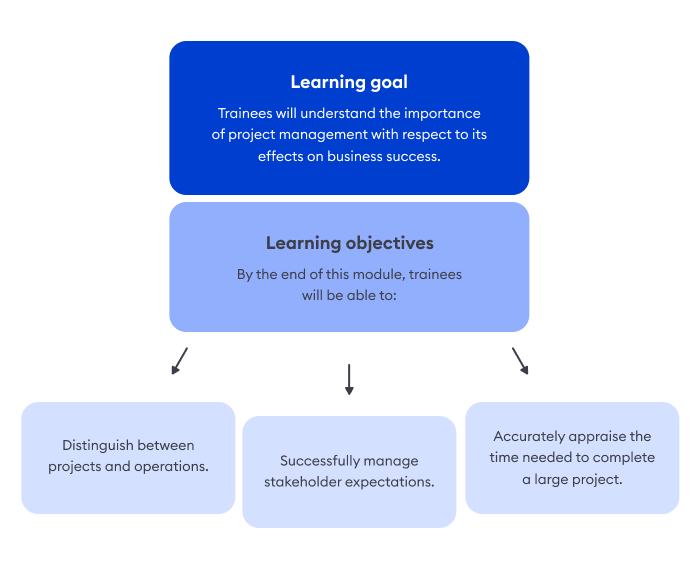
Step 3: Choose learning methods and design training materials
Once you know what you need to train for, you need to determine the best way to accomplish it. There are multiple learning methods:
- Online courses
- Instructional videos
- Lectures
- Workshops
- Others
Select the best one for your context, and then create training materials. If you want to design online training content, you’ll need an authoring tool — for example, iSpring Suite. It allows you to create interactive online courses and quizzes, dialogue simulations, and record and edit video lectures. In our case with Zoom, we would record an instructional video with iSpring Suite to introduce Zoom’s features and explain how to use them.
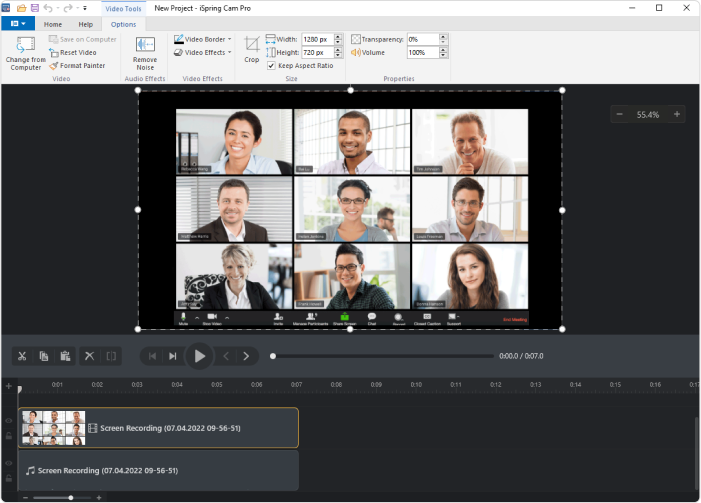
We would also create an interactive quiz with the same tool, to check how well trainees have acquired new knowledge.
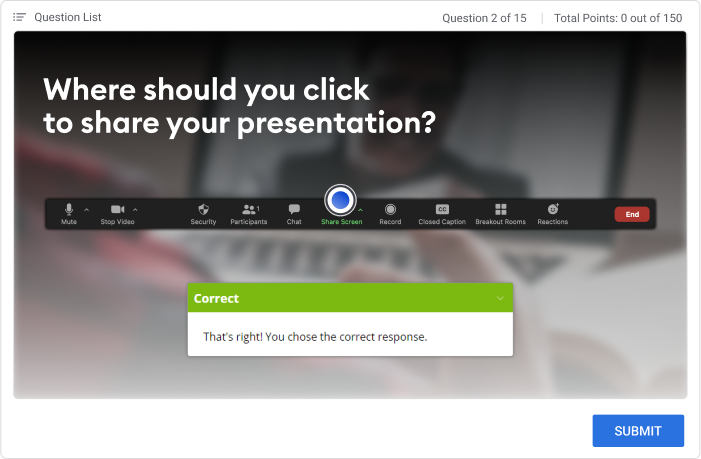
Step 4: Deliver training
Although delivering and evaluating training programs aren’t exactly “content development” processes, they are an obligatory part of developing and launching an L&D program. That’s why we’ll cover them, too.
Your training program delivery method depends on the type of training content. For a lecture or a workshop, you need to organize a face-to-face training session, get a classroom, invite employees and a coach, or create and schedule an online conference.
If you have content such as an online course, a video, or any other digital type of content, the best way to deliver it is through a learning management system (LMS). An LMS is an L&D tool that stores all of your training materials, assigns them to your learners, notifies them of due dates, and generates detailed reports about trainee progress.
In our case, we would upload our training video and an online quiz to iSpring Learn LMS, assign employees who struggle using new software, and wait for reports.
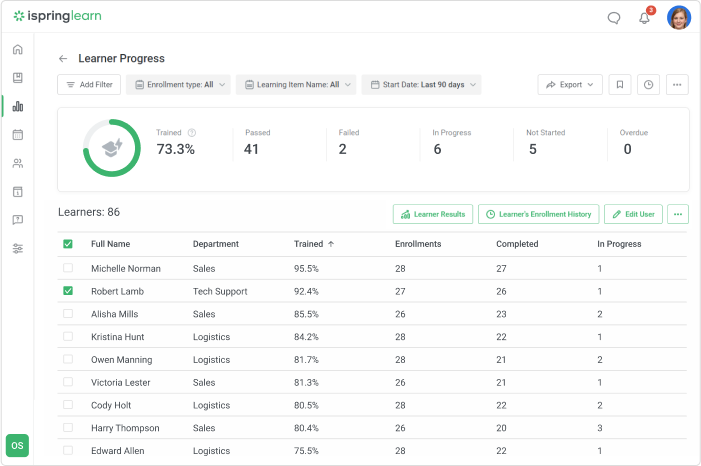
Step 5: Evaluate your training program
It is vital to assess the quality of your training program and identify potential learning gaps or errors that need to be fixed. To do this, you’ll need learner progress reports generated by your LMS and training evaluation models.
Progress reports show the courses a trainee has completed, how much time they spent on the courses, their scores on quizzes, and more. In our software example, we would analyze trainee progress reports to see how many employees completed the video and passed the quiz.
Training evaluation models include the data from progress reports, along with results of other evaluation methods, such as ROI, survey results, and 360-degree feedback assessment. They provide algorithms you can use to identify the effectiveness of your training program. There are many models, so it’s best if you explore them and choose the one that’s most appropriate for your situation. For example, we would use Kirkpatrick’s model of evaluation to assess how engaged trainees were in the training process and how the L&D program affected their performance.
Follow our guide on measuring training effectiveness if you decide to use the same model.
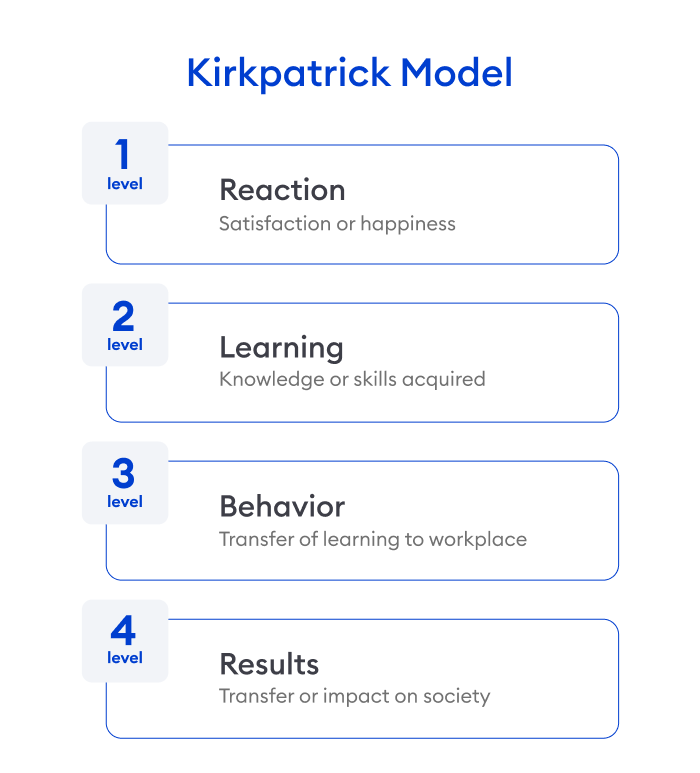
Based on the results, you should either change your learning method and training materials (if the training program proved ineffective) or continue delivering the training program as it is, when needed, and revise it regularly.
How to Formulate a Winning Learning and Development Strategy
There is no single winning strategy for all companies, as each one is a unique case with objectives that require an individualized approach. However, there are some general factors you might want to consider when formulating your L&D strategy to make sure it’s effective. We’ve collected tips that’ll help you work out these factors — check them out:
Align an L&D strategy with the business strategy
The ultimate goal of learning and development is to drive business success. And you can only achieve this if you consider the business goals when formulating your L&D strategy. If your business strategy involves digital transformation, for example, then your L&D strategy should address the issue, too: conduct training online, design software tutorials, and more.
If L&D and business strategies don’t align, you won’t get the needed results. Imagine two people trying to move a table. One thinks the table should go to the left; the other, to the right. As a result, the table remains at the same place, and people get tired. That’s what happens when business and L&D strategies don’t align.
Create individual learning paths
Employees are usually really busy and don’t like to leave their duties for a training session. Take salespeople as an example. They might find it difficult to sit through an hour-long session while they know potential clients are waiting. Some employees don’t feel comfortable practicing new skills and knowledge with their team members, as there’s a risk of public failure. Of course, you can force all staff to visit training sessions, but this won’t be the best way if you aim for true knowledge and skill development.
Also read: Retail Sales Training – How to Move It Online
Modern tools allow you to conduct most training online and make it personalized. As an L&D specialist, you can create individual learning paths for each job position, department, and employee. Instead of bringing entire teams together and coaching them in skills some of them don’t need, let them learn and practice what they genuinely need to perform their current role in the company better. This approach, combined with social learning, hands-on training, and mentoring, can yield great results.
Also read: Mentorship Program: All You Should to Know in 2023 [Expert Insights]
Make flexibility a core principle
In a fast-changing world, the only guarantee of stability is flexibility. Consider making it your principle in everything you do, from formulating a learning and development strategy to creating training content. You should be able to revise your L&D strategy to keep it relevant and effective. And it’s best if you make your training flexible, so that employees can easily adjust it to their schedules.
Let’s say you want your trainees to take an online course. Design the course to look good on any device, because some employees will take it on their smartphone or tablet while going home, and others will access it on their laptops.
Don’t worry about employee turnover
Some businesses consider it a dilemma whether they should provide training for their employees. They fear that they will invest significant resources to develop employees’ skills, and then the employees will leave. There’s even a meme about this that offers a counterargument:
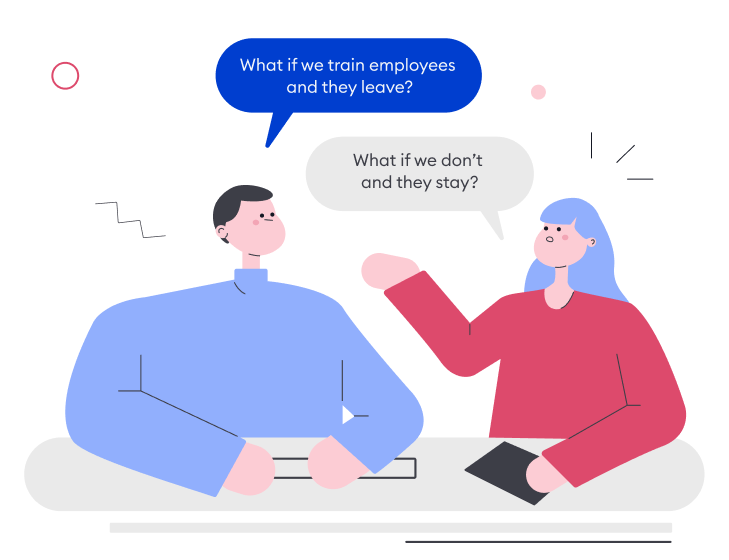
Learning and development is an essential part of business success, so it’s not an option not to train your employees — you need to, if you aim high. Besides, as we’ve mentioned earlier, they are more likely to stay if you invest in their development. So don’t worry about employee turnover — create engaging, meaningful L&D programs, and your employee retention will grow along with your business productivity.
Try the 70:20:10 learning model
The 70:20:10 learning model proposes that 70% of learning should come from challenging assignments, 20% from developmental relationships, and 10% from coursework and training. Though there’s no universally accepted opinion on whether this learning model is always precise, it has proved helpful in many cases. Try it and see if it’s useful for your business!
Pick the right L&D tools
When you decide to build a house, a crucial step toward achieving your goal is getting the right tools. The same can be said for launching and running L&D. Whichever approach you choose, whichever methods you decide to use, you will need software to make it happen.
A traditional online learning and development program requires at least two tools: a course authoring tool, to design training content, and a learning management system, to deliver the content and track trainee progress. You might also need a web-conferencing tool, to conduct virtual training sessions, and a communication tool, to enable social learning. Check out the best learning and development tools to find the perfect solution for your case.
To Sum Up
Learning and development is a must-have for any business because it allows companies to keep pace with the dynamic world, enhance work performance, and increase employee retention, satisfaction, and productivity. While launching and running successful L&D is not an easy task, there are some fundamental factors to consider and tips that will help you go through this process smoother and smarter. Feel free to bookmark this article to keep our guide and tips on hand when you need them.
You can start creating and delivering L&D programs right now — download our free trials of iSpring Suite (14 days) and iSpring Learn LMS (30 days).
Good luck!


